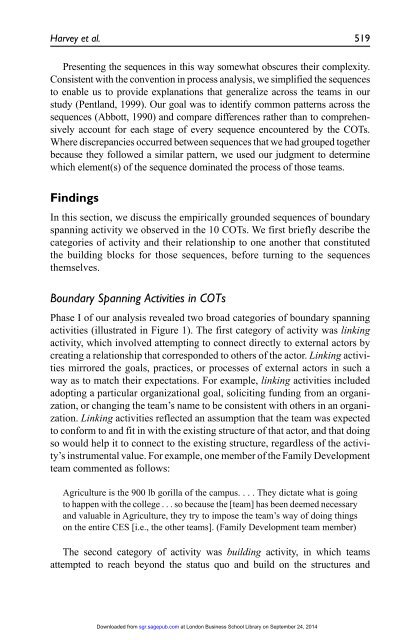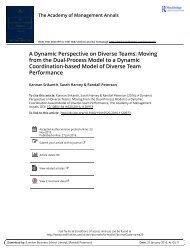The Process of Team Boundary Spanning in Multi-Organizational Contexts - Sarah Harvey, Randall S. Peterson, and N. Anand
Work teams must increasingly operate in complex environments characterized by multiple external actors beyond team and organizational boundaries. Although previous research demonstrates the importance of boundary spanning activities to team effectiveness, it reveals relatively little about the process of boundary spanning in these environments. In this article, we investigated the processes of boundary spanning across multiple external actors in 10 cross-organizational teams. We identified three sequences for reaching out to external actors: (a) moving inside-out from vertical actors inside the host organization to horizontal actors outside of the host organization, (b) moving outside-in from horizontal actors to vertical, and (c) staying-inside with vertical actors from the host organization. Our observations suggest that inside-out and outside-in sequences were more successful than simply pleasing the host organization. We build on our empirical findings to develop a process theory of how team boundary spanning activities across multiple external actors influence team effectiveness. Our research underscores the importance of a team’s interactions with actors in its external environment beyond those in an immediate supervisory role and provides insight into the dynamics of boundary spanning in multi-organizational contexts.
Work teams must increasingly operate in complex environments
characterized by multiple external actors beyond team and organizational
boundaries. Although previous research demonstrates the importance of
boundary spanning activities to team effectiveness, it reveals relatively little
about the process of boundary spanning in these environments. In this article,
we investigated the processes of boundary spanning across multiple external
actors in 10 cross-organizational teams. We identified three sequences for
reaching out to external actors: (a) moving inside-out from vertical actors inside
the host organization to horizontal actors outside of the host organization,
(b) moving outside-in from horizontal actors to vertical, and (c) staying-inside
with vertical actors from the host organization. Our observations suggest
that inside-out and outside-in sequences were more successful than simply
pleasing the host organization. We build on our empirical findings to develop
a process theory of how team boundary spanning activities across multiple
external actors influence team effectiveness. Our research underscores the
importance of a team’s interactions with actors in its external environment beyond those in an immediate supervisory role and provides insight into the
dynamics of boundary spanning in multi-organizational contexts.
Create successful ePaper yourself
Turn your PDF publications into a flip-book with our unique Google optimized e-Paper software.
<strong>Harvey</strong> et al. 519<br />
Present<strong>in</strong>g the sequences <strong>in</strong> this way somewhat obscures their complexity.<br />
Consistent with the convention <strong>in</strong> process analysis, we simplified the sequences<br />
to enable us to provide explanations that generalize across the teams <strong>in</strong> our<br />
study (Pentl<strong>and</strong>, 1999). Our goal was to identify common patterns across the<br />
sequences (Abbott, 1990) <strong>and</strong> compare differences rather than to comprehensively<br />
account for each stage <strong>of</strong> every sequence encountered by the COTs.<br />
Where discrepancies occurred between sequences that we had grouped together<br />
because they followed a similar pattern, we used our judgment to determ<strong>in</strong>e<br />
which element(s) <strong>of</strong> the sequence dom<strong>in</strong>ated the process <strong>of</strong> those teams.<br />
F<strong>in</strong>d<strong>in</strong>gs<br />
In this section, we discuss the empirically grounded sequences <strong>of</strong> boundary<br />
spann<strong>in</strong>g activity we observed <strong>in</strong> the 10 COTs. We first briefly describe the<br />
categories <strong>of</strong> activity <strong>and</strong> their relationship to one another that constituted<br />
the build<strong>in</strong>g blocks for those sequences, before turn<strong>in</strong>g to the sequences<br />
themselves.<br />
<strong>Boundary</strong> <strong>Spann<strong>in</strong>g</strong> Activities <strong>in</strong> COTs<br />
Phase I <strong>of</strong> our analysis revealed two broad categories <strong>of</strong> boundary spann<strong>in</strong>g<br />
activities (illustrated <strong>in</strong> Figure 1). <strong>The</strong> first category <strong>of</strong> activity was l<strong>in</strong>k<strong>in</strong>g<br />
activity, which <strong>in</strong>volved attempt<strong>in</strong>g to connect directly to external actors by<br />
creat<strong>in</strong>g a relationship that corresponded to others <strong>of</strong> the actor. L<strong>in</strong>k<strong>in</strong>g activities<br />
mirrored the goals, practices, or processes <strong>of</strong> external actors <strong>in</strong> such a<br />
way as to match their expectations. For example, l<strong>in</strong>k<strong>in</strong>g activities <strong>in</strong>cluded<br />
adopt<strong>in</strong>g a particular organizational goal, solicit<strong>in</strong>g fund<strong>in</strong>g from an organization,<br />
or chang<strong>in</strong>g the team’s name to be consistent with others <strong>in</strong> an organization.<br />
L<strong>in</strong>k<strong>in</strong>g activities reflected an assumption that the team was expected<br />
to conform to <strong>and</strong> fit <strong>in</strong> with the exist<strong>in</strong>g structure <strong>of</strong> that actor, <strong>and</strong> that do<strong>in</strong>g<br />
so would help it to connect to the exist<strong>in</strong>g structure, regardless <strong>of</strong> the activity’s<br />
<strong>in</strong>strumental value. For example, one member <strong>of</strong> the Family Development<br />
team commented as follows:<br />
Agriculture is the 900 lb gorilla <strong>of</strong> the campus. . . . <strong>The</strong>y dictate what is go<strong>in</strong>g<br />
to happen with the college . . . so because the [team] has been deemed necessary<br />
<strong>and</strong> valuable <strong>in</strong> Agriculture, they try to impose the team’s way <strong>of</strong> do<strong>in</strong>g th<strong>in</strong>gs<br />
on the entire CES [i.e., the other teams]. (Family Development team member)<br />
<strong>The</strong> second category <strong>of</strong> activity was build<strong>in</strong>g activity, <strong>in</strong> which teams<br />
attempted to reach beyond the status quo <strong>and</strong> build on the structures <strong>and</strong><br />
Downloaded from sgr.sagepub.com at London Bus<strong>in</strong>ess School Library on September 24, 2014
















